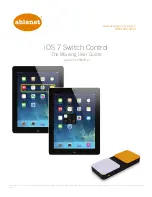
5
the pacemaker for making and receiving calls on your smartphone to minimize the potential
interference. If you have any reason to suspect that interference is taking place, turn off all
wireless connections on your smartphone immediately, stop using your smartphone, and
consult a physician.
Hearing aids:
Some digital wireless devices might interfere with some hearing aids. In the
event of such interference, consult your wireless service provider or contact the manufacturer
of your hearing aid to discuss alternatives.
Your smartphone includes a magnetometer, which is used by applications such as the
Compass. If an application that uses the magnetometer causes interference with your hearing
aid, close the application.
Other medical devices:
If you use any other personal medical device, consult the
manufacturer to determine if your medical device is adequately shielded from external radio
frequency energy. Your physician might be able to assist you in obtaining this information.
Health care facilities:
Turn off all wireless connections on your smartphone in health care
facilities when any regulations posted in these areas instruct you to do so. Hospitals or health
care facilities might be using equipment that could be sensitive to external radio frequency
energy.
Aircraft:
Turn off all wireless connections on your smartphone before boarding an aircraft. The
effect of using the smartphone with wireless connections turned on in an aircraft is unknown.
Such use might affect aircraft instrumentation, communication, and performance, might
disrupt the network, might otherwise be dangerous to the operation of the aircraft, and might
be illegal. With all wireless connections on your smartphone turned off, use only nonradio
based device applications in accordance with airline regulations for electronic devices.
Dangerous areas
Your smartphone is not an intrinsically safe device and is not suitable for use in hazardous
environments, where intrinsically safe devices are required, including without limitation, in
the presence of gas fumes, explosive dust situations, operation of nuclear facilities, aircraft
navigation or communication services, air traffic control, and life support or weapons systems.
Potentially explosive atmospheres:
If you are in any area with a potentially explosive
atmosphere, turn off all wireless connections on your smartphone and obey all signs and
instructions. Sparks in such areas could cause an explosion or fire resulting in bodily injury
or even death.
Areas with a potentially explosive atmosphere are often, but not always, clearly marked.
They include fueling areas such as gasoline or petrol stations; below deck on boats; fuel
or chemical transfer or storage facilities; vehicles using liquefied petroleum gas, such as
propane or butane; areas where the air contains chemicals or particles, such as grain, dust,
or metal powders; and any other area where you would normally be advised to turn off your
vehicle engine.
Do not use the smartphone to report a gas leak in the vicinity of the leak. Leave the area and
make the call from a safe location, if the phone is available and active on your smartphone.
Blasting areas:
When in a “blasting area” or an area that indicates that two-way radios should
be turned off, to avoid interfering with blasting operations, turn off all wireless connections on
your smartphone and obey all signs and instructions.
Operating and storage temperatures
Your smartphone and smartphone charger are designed to be operated and stored within the
temperatures outlined below:
Smartphone operating:
32 to 113°F (0 to 45°C)
Smartphone storage (less than 3 months):
-4 to 113°F (-20 to 45°C)
Smartphone storage (3 months or more):
77°F (25°C +/- 3°C)
Charger operating:
32 to 104°F (0 to 40°C)
Usage or storage of your smartphone or smartphone accessories outside of the recommended
temperature ranges could cause your smartphone to become hot which could result in serious
injury or death, or could cause damage to the smartphone, the accessories, or the lithium-ion
battery.
Keep your smartphone or smartphone accessories away from heat sources, such as radiators,
heat registers, stoves, or other apparatus (including amplifiers) that produce heat. If you are
not going to use your smartphone for more than two weeks, turn off the power.
Smartphone cleaning and repair
Cleaning:
Do not use liquid, aerosol cleaners, or solvents on or near your smartphone or
smartphone accessories, including the battery. Clean only with a soft dry cloth. Disconnect
any cables from the computer and unplug any charging accessories from the electrical outlet


























